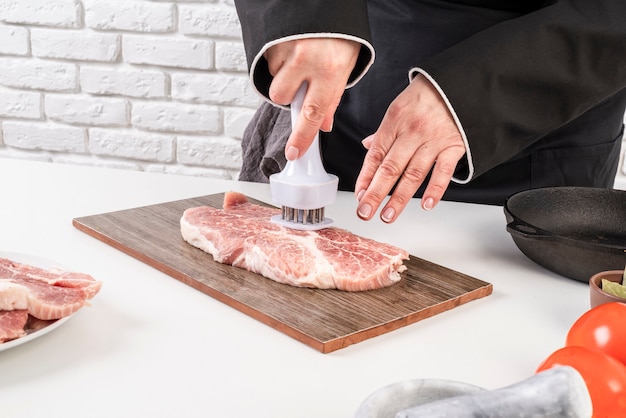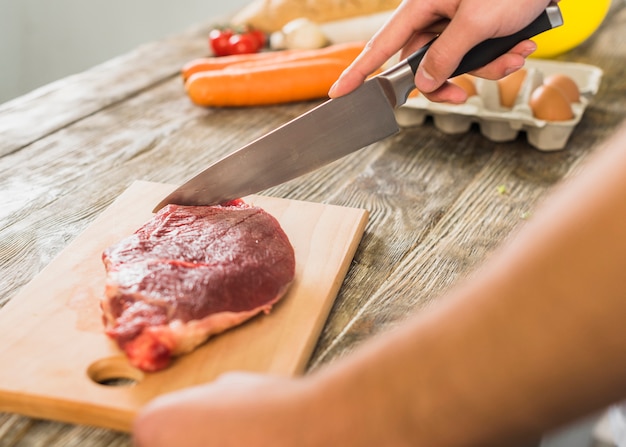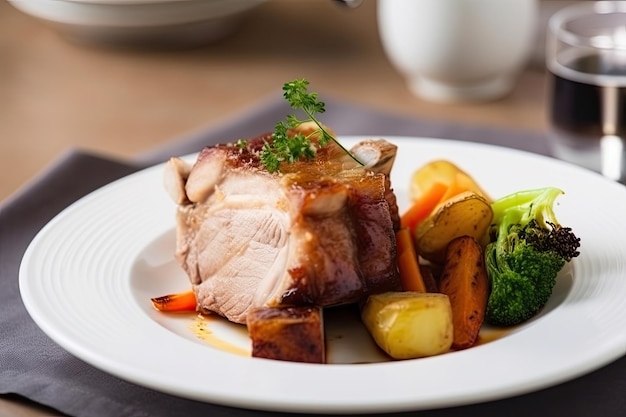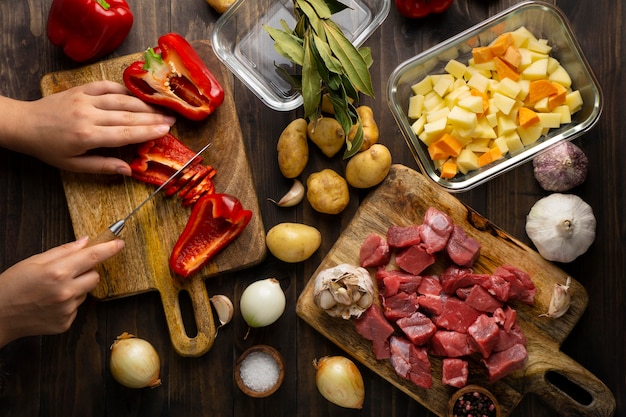It's a classic scene: you're standing in the kitchen, a beautiful piece of pork loin in your hand, ready to create a delicious meal. But then, the question pops up: how long do you cook those chops? I've been there, recipe in hand, staring at the timer, wondering if I'll end up with dry, tough meat or a succulent feast. Trust me, there's a lot more to it than just tossing them in the pan and hoping for the best.
Over the years, I've learned a thing or two about cooking pork chops. It's been a journey of trial and error, with a few kitchen mishaps along the way, but I've also discovered some golden rules that have helped me consistently achieve juicy, flavorful results. So, let's dive in together and explore the art of cooking perfect pork loin chops.
(Part 1) The Anatomy of a Pork Loin Chop

Understanding the Cut: A Lean, Versatile Choice
First things first, let's get acquainted with the star of the show. Pork loin chops come from the loin, a long, lean muscle running along the back of the pig. It's known for its delicate flavour and lean profile, meaning it has less fat compared to other cuts like the shoulder or belly. This makes it a fantastic choice for grilling, pan-frying, or roasting, as it cooks quickly and doesn't need a lot of extra fat to stay moist.
Thickness Matters: A Key Factor in Cooking Time
Now, here's where things get a bit more nuanced. The cooking time for a pork loin chop is significantly influenced by its thickness. You'll find chops ranging from about 1 inch to 2 inches thick, and that difference in thickness can be the deciding factor between a perfectly cooked chop and one that's overcooked and dry.
I've learned this lesson the hard way. I remember one time, I was so eager to get dinner on the table that I tossed some thick-cut chops onto the grill without checking their thickness. Can you guess what happened? They ended up overcooked on the outside and raw in the middle! Not exactly a culinary triumph, I can tell you.
(Part 2) Choosing the Right Method: Your culinary journey Begins

Pan-Frying for a quick and easy meal: Simplicity at Its Best
Pan-frying is a simple and versatile technique that's perfect for smaller chops, especially when you're looking for a quick and delicious weeknight meal. You can achieve those beautiful grill marks without firing up the grill, giving you a taste of summer even in the depths of winter. I usually prefer a cast-iron skillet for that extra bit of heat retention, but any heavy-bottomed pan will do the trick.
Here's the secret: heat your pan over medium-high heat, add a drizzle of oil, and then sear the chops for a couple of minutes on each side. This creates a delicious, crispy crust and locks in the juices, ensuring a tender and flavourful chop.
Grilling for That Smoky Flavor: Embracing the Outdoors
Grilling is my personal go-to method for pork loin chops, especially during those warm summer months. The smoky flavour from the grill adds a whole new dimension to the taste, transforming a simple chop into a flavour explosion.
For grilling, make sure your grill is nice and hot, reaching medium-high heat. You'll want those iconic grill marks, so don't be afraid to let them sear for a couple of minutes per side. Remember, the more intense the heat, the more pronounced those flavourful grill marks will be.
oven roasting for a More Hands-Off Approach: Perfect for Busy Evenings
Oven roasting is a fantastic choice when you're looking for a more hands-off approach, perfect for busy evenings or when you want to cook a larger batch of chops. It's also ideal for thicker cuts, as it ensures even cooking throughout the entire chop. Preheat your oven to 375°F (190°C), season your chops with your favourite spices, and then place them on a baking sheet.
I personally love to roast pork chops with a blend of rosemary, thyme, and garlic. It's a simple combination, but the aromatic herbs add a complex and satisfying flavour.
(Part 3) Essential Tools: Don't Forget Your Thermometer

Now, let me share a piece of advice I wish I had known when I first started cooking: don't rely on guesswork. Invest in a good meat thermometer. Trust me, it's a game-changer, especially when dealing with pork.
A meat thermometer takes the guesswork out of cooking and ensures that your pork reaches the safe internal temperature of 145°F (63°C). It's all about food safety and peace of mind.
I remember a time when I was cooking pork chops for a family gathering. I thought I had cooked them long enough, but when I checked with my thermometer, they were still undercooked. Thankfully, I caught it in time, but it was a close call.
(Part 4) Cooking Times for Different Thicknesses: Mastering the Timing
Alright, now that we've got the basics covered, let's talk about those cooking times. As I mentioned earlier, the thickness of your chops plays a crucial role in determining how long you need to cook them.
Cooking Times for Pan-Frying and Grilling: A Quick Reference Guide
Here's a general guideline for pan-frying and grilling, but remember, it's always best to check the internal temperature with a meat thermometer:
| Chop Thickness | Cooking Time Per Side |
|---|---|
| 1 inch | 3-4 minutes |
| 1.5 inches | 4-5 minutes |
| 2 inches | 5-6 minutes |
These are just estimates, and your cooking time might vary slightly depending on your pan or grill's heat.
Cooking Times for Oven Roasting: A More Relaxed Approach
For oven roasting, the cooking time will depend on the thickness of your chops and your desired level of doneness.
- For 1-inch thick chops, roast for 15-20 minutes.
- For 1.5-inch thick chops, roast for 20-25 minutes.
- For 2-inch thick chops, roast for 25-30 minutes.
Remember, those are just general guidelines. Use a meat thermometer to ensure your chops reach 145°F (63°C) for safe and delicious results.
(Part 5) Resting: The Key to Juicy, tender pork
Now, here's a tip that might surprise you: let your chops rest. It may seem counterintuitive, but resting is crucial for achieving juicy, tender pork.
Think of it this way: when you cook pork, the juices get pushed to the edges. Resting allows those juices to redistribute evenly throughout the chop, resulting in a more flavorful and tender piece of meat.
I usually let my chops rest for about 5-10 minutes before slicing and serving, allowing them to cool down slightly and the juices to redistribute.
(Part 6) How to Tell if Your Pork Loin Chops are Cooked: Beyond the Thermometer
We've talked about cooking times and thermometers, but sometimes you just need to know how to tell if your chops are cooked without using any fancy tools. Here are a few visual and tactile cues to look for:
The Colour Test: A Visual Indicator
The colour of the pork is a good indicator of doneness.
- Raw pork is a light pink colour, often with a slightly translucent appearance.
- As the pork cooks, it will turn a pale pink or white, becoming more opaque.
The Feel Test: A Tactile Check
You can also get a sense of the doneness by pressing on the chop with a finger.
- A raw chop will be soft and spongy, yielding to pressure.
- A cooked chop will feel firm and springy, offering gentle resistance.
Keep in mind that these visual and tactile cues are best used in combination with a meat thermometer for the most accurate results.
(Part 7) Common Mistakes to Avoid: Lessons Learned from the Kitchen
I've made my fair share of mistakes in the kitchen, and I'm sure you have too. So, let's talk about some common errors to avoid so you can avoid my culinary mishaps:
Overcrowding the Pan: Space is Key
One of the biggest mistakes people make is overcrowding the pan. This can lead to uneven cooking, as the chops will steam instead of sear. Give your chops enough space to breathe and create that beautiful crust.
Cooking at Too Low a Temperature: Heat is Your Friend
Another common mistake is cooking at too low a temperature. This can result in dry, tough chops. Make sure your pan or grill is hot enough to create a quick sear and lock in the juices.
Not Resting: Patience is a Virtue
And, of course, we've already mentioned the importance of resting your chops. Don't skip this step! It's a simple but essential technique for ensuring juicy, flavorful results.
(Part 8) Tips for the Most Delicious Pork Loin Chops: Elevating Your Culinary Game
Let's wrap things up with a few tips for making your pork loin chops absolutely delicious, transforming them from a simple meal to a culinary masterpiece:
Seasoning is Key: The Magic of Flavor
Don't underestimate the power of seasoning. Salt and pepper are a must, but you can also experiment with other herbs and spices like garlic powder, paprika, onion powder, or even a sprinkle of chili powder for a bit of heat.
Don't Be Afraid to Marinate: A Symphony of Flavors
Marinating your chops before cooking can add a burst of flavour, infusing them with a symphony of tastes. There are tons of marinade recipes online, so feel free to experiment and find your favorite. I love using a simple marinade of soy sauce, honey, and garlic.
Add a side dish: Completing the Meal
No pork chop meal is complete without a side dish! Roasted vegetables, mashed potatoes, or a simple green salad are always delicious companions.
Experiment with Different cooking techniques: Expanding Your Culinary Horizons
Don't be afraid to experiment with different cooking techniques. Try pan-searing your chops and then finishing them in the oven, or grilling them over indirect heat for a more smoky flavor. The possibilities are endless!
(Part 9) FAQs: Answering Your Pork Chop Questions
1. Can I freeze pork loin chops?
Yes, you can freeze pork loin chops. Wrap them tightly in plastic wrap or aluminum foil, and then place them in a freezer-safe bag. They can be frozen for up to 3 months.
2. How do I thaw frozen pork loin chops?
You can thaw frozen pork loin chops in the refrigerator overnight or by placing them in a bowl of cold water for about 30 minutes.
3. What happens if I overcook pork loin chops?
If you overcook pork loin chops, they will be dry and tough. The best way to avoid this is to use a meat thermometer and cook them to an internal temperature of 145°F (63°C).
4. What are some good ways to serve pork loin chops?
Pork loin chops can be served with a variety of side dishes, including roasted vegetables, mashed potatoes, rice, or pasta. They also go well with sauces like gravy, apple sauce, or a simple pan sauce made with wine and herbs.
5. Can I use pork loin chops in other dishes?
Absolutely! Pork loin chops can be used in a variety of dishes, including stir-fries, curries, and even soups.
And there you have it. Hopefully, you're now armed with the knowledge and confidence to cook those pork loin chops like a pro! Remember, practice makes perfect, and I'm sure you'll be serving up juicy, delicious pork chops in no time. Happy cooking!
Everyone is watching

Perfect Rice Every Time: The Ultimate Guide to Cooking Rice
Cooking TipsAs a self-proclaimed foodie, I've always been a bit obsessed with rice. It's the foundation of countless cuisi...

Ultimate Guide to Cooking the Perfect Thanksgiving Turkey
Cooking TipsThanksgiving. Just the word conjures up images of overflowing tables laden with delicious food, the scent of r...

The Ultimate Guide to Cooking Asparagus: Tips, Techniques, and Recipes
Cooking TipsAsparagus. The mere mention of this spring delicacy conjures up images of vibrant green spears, crisp and burs...

Can You Cook Spaghetti with Gasoline? (The Shocking Truth)
Cooking TipsWe've all seen those crazy internet trends. You know, the ones that make you wonder, "Did someone actually try...

Chorizo and Eggs Recipe: The Ultimate Guide
Cooking TipsRight, let’s talk about chorizo and eggs. You know, that classic Spanish dish that's always a winner. It's th...
